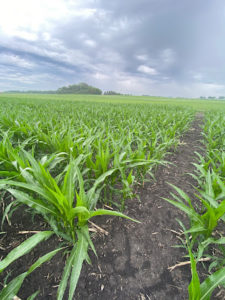By: Manuel Sabbagh and Melissa Wilson
Key Points
- Interseeding cover crops produces greater biomass than drilling cover crops after harvest.
- In rotations where corn follows corn (sweet corn or silage), late fall application of manure (when soils are below 50°F but prior to freezing) sustains or improves yield compared to spring-applied fertilizer.
What We Did
The objectives of this study were multi-faceted. First, we wanted to explore various cover crop planting methods and planting times in order to have consistency in cover crop establishment and keep the soil covered year-round. Second, we wanted to see if cover crops can retain nutrients from fall-applied liquid-injected manure, even if the manure was injected a little earlier in the fall than we usually recommend. (Typically, we recommend injecting manure when soil temperatures cool down to 50°F or below.) Lastly, we wanted to measure the effects that integrating liquid-injected manure and cover crops have on soil health, nutrient cycling, and agronomic production.
- Continuous silage corn in Morris, MN: A winter rye/annual ryegrass cover crop mix was either interseeded at the 4th leaf collar stage (V4), overseeded at the kernel dent stage (R5), or drilled after harvest in mid-September. Then, liquid dairy manure was injected into each cover crop planting combination in late September/early October or late October/early November, before and after soil temperatures had cooled to or below 50°F.
- Soybean followed by corn in Morris and Waseca, MN: A winter rye/annual ryegrass mix was overseeded near the time of leaf drop in September or it was drilled after soybean harvest. Since the soybeans weren’t harvested until mid-October, we only injected swine manure in late fall (late October/early November) once the soil temperature was below 50°F.
- Sweet corn followed by grain corn in Waseca, MN: Winter rye, oats, or a winter rye/oat/radish mix was drilled after sweet corn harvest in mid-August. Similar to the continuous corn rotation, liquid swine manure was injected in mid- to late-September or late October/early November.
What Did We Find?
- Prior to the first frost in fall, non-manured plots had significantly greater cover crop biomass than the manured plots but in spring, cover crop biomass was similar in plots that had manure or no manure.
- Applying dairy manure in early or late fall had significantly higher silage yield than spring-applied fertilizer.
- Overseeding cover crops at R5 was more successful at producing increased cover crop biomass, whereas interseeding at V4 produced higher silage yields compared to the other cover cropped plots.
- There were no significant differences in silage yield when comparing plots that did or did not have a cover crop planted in fall prior to corn planting.
- Fall cover crop biomass was significantly greater when overseeded near soybean leaf drop compared to drilling after harvest. However, within each of those planting methods, there was no difference in biomass production between manure and no manure.
- Spring 2020 cover crop biomass followed a similar trend to fall data. However, in spring 2021, overseeding near leaf drop with no manure application produced greater cover crop biomass than overseeding with manure and drilling after harvest, with or without manure.
- Corn grain yield did not differ between manure or spring-applied fertilizer or among the cover crop treatments, including no cover crop.
- Cover crop biomass production was similar across cover crop types in fall regardless of whether manure was applied or not.
- In spring 2020, cover crop biomass was just as high or higher in manured plots compared to non-manured plots, with single-species rye producing greater biomass than the mixture.
- In spring 2021, plots with early fall manure application consistently had greater biomass than non-manured plots and late fall manure application with no consistent effect of cover crop type.
- Early fall application of liquid swine manure reduced corn yield compared with spring fertilizer application by 6.5% on average. Late fall manure application increased yield by 13.2% in 2020 and had similar yield to spring fertilizer plots in 2021 (a dry year).
- Cover crops that survived the winter resulted in a small grain yield penalty (19-20 bu/acre) compared to no cover crops.
What's Next?





Post a comment
Report Abusive Comment